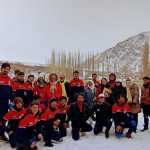CPEC unfolding opportunities for Pakistan
China Pakistan Economic Corridor by supplementing Pakistan’s socio-economic development as the tremendous human capital of the region has been proving as the biggest asset for the country.
By marking the 10th anniversary of its launch under the flagship project of Belt and Road Initiative, CPEC has unfolded substantial opportunities for Pakistan, promising a prosperous and peaceful future for the Pakistani people.
Launched in 2013, CPEC is a corridor linking Pakistan’s Gwadar Port with Kashgar in northwest China’s Xinjiang Uygur Autonomous Region which highlights agriculture, energy, transport, trade and industrial cooperation.
With investment in the country’s modern transportation networks including roads and railways, energy projects, ports and special economic zones, the CPEC has provided the opportunity for Pakistan to promote development and economic growth.
CPEC, a flagship project of the China-proposed Belt and Road Initiative (BRI), is linked with the long-lasting economic benefits and sustainable development for the people of Pakistan that has generated thousands of jobs for local people by tackling the energy crisis of the country.
CPEC has played a significant role in promoting the in-depth development of the Pakistan-China all-weather strategic cooperative partnership and the high-quality development of the BRI, which has grabbed attention in Pakistan and around the world.
Since the launch of CPEC, China has become the top destination for Pakistan’s students and there are strong links between our people nurtured by artists, academia, the scientific community and the media. It meets the people’s aspirations, wins the people’s hearts and benefits the people’s livelihoods.
With the joint efforts of the two governments, enterprises and all sectors of society, CPEC cooperation has achieved fruitful results and made a great contribution to Pakistan’s national construction and regional interconnection.
Despite numerous obstacles, Pakistan has witnessed economic development in the region as projects under CPEC made major progress over the past few years.
CPEC has shown strong resilience against the challenges such as the COVID-19 pandemic. The staff and workers of the two countries working on CPEC projects have worked dedicatedly hand-in-hand to overcome the difficulties and written a new moving story of Pakistan-China friendship.
The high-quality development of CPEC would certainly provide significant opportunities for the development of Pakistan and countries along the BRI route, helping them implement the global goals for regional prosperity.
CPEC will supplement Pakistan’s socio-economic development as the tremendous human capital of the region is its biggest asset.
China has assisted Pakistan in power projects generating 5,200 MW while 886-km national transmission Network has been completed. Besides, 510-km roads have been constructed under the CPEC. Moreover, 7,000 sets of solar energy cells have been installed in Gwadar to address the energy needs.
The CPEC project has generated huge employment opportunities and out of 5,000 jobs generated in Gwadar, 4,000 are local employees.
After the completion of the first phase of the CPEC, various projects in the field of agriculture, industry, science & technology are being undertaken on priority.
China has played a key role in creating regional awareness to underscore the significance of cultural and educational exchanges through its ventures like the Belt and Road Initiative (BRI) and the China-Pakistan Economic Corridor (CPEC), resulting in substantial educational, political, economic, and trade cooperation among various countries and regions. The economic zones being established in the country’s Khyber Pakhtunkhwa (KP), Punjab, Sindh and Baluchistan provinces would bring about immense opportunities for Pakistani people in job and business sectors.
The potential industries being set up in the CPEC special economic zones include food processing, cooking oil, ceramics, gems and jewelry, marble, minerals, agriculture machinery, iron and steel, motorbike assembling, electrical appliances and automobiles.
While globalization is coming under stress, we need to look at China as an example of socio-economic development. CPEC, together with China’s Global Development Initiative and Global Security Initiative, is pivotal for Pakistan to address the sustainability issues, and the integration of security and technology.
CPEC has spread a vast network of roads from the south, east and north of Pakistan, making the tourist resorts in north Pakistan accessible to tourists, and it will play a vital role in the revival of the tourism sector.
Currently, 300,000 people in the country are associated with the tourism industry, and with an uptick in the number of tourists in the country due to better roads and connectivity, the number is likely to increase to 500,000 in the coming years.
Saudi Arabia, United Arab Emirates (UAE) and Germany are among those that have taken moves on the cooperation with Pakistan via the flagship project. As China extends a welcoming attitude toward the investment, it is believed that the CPEC would continue to attract more third-country investors.
For Saudi Arabia, its intention to invest in CPEC projects started as early as 2019 when the Middle Eastern country announced plans to set up a $10 billion oil refinery in Pakistan’s deep-water port of Gwadar.
The CPEC has brought Pakistan direct investment totaling $25.4 billion over the past years while many more is expected to be pumped under this project in Pakistan that may cultivate huge benefits for Pakistan in the future.










